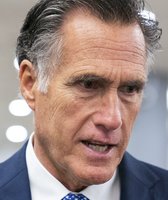Get PolitiFact in your inbox.

President Donald Trump speaks during an event to honor Dr. Martin Luther King Jr., in the Roosevelt Room of the White House, Friday, Jan. 12, 2018, in Washington. (AP Photo/Evan Vucci)
President Donald Trump has shocked people for using disparaging language during a meeting about protections for immigrants from Haiti, El Salvador and African countries.
"Why are we having all these people from shithole countries come here?" Trump is reported as saying. He made the remarks in discussion with a small group of lawmakers about potential immigration legislation.
The Jan. 11 meeting was part of ongoing talks to strike a deal for so-called Dreamers, young immigrants who came to the United States as children and live here illegally, at risk of deportation.
In return for allowing Dreamers to stay, Trump wants to eliminate a diversity visa lottery program that allows in 50,000 immigrants per year from countries with low levels of immigration to the United States. Many Africans come to the United States through this program.
As for El Salvador and Haiti, the Trump administration recently eliminated the Temporary Protected Status designation for the two countries, which protected its nationals from being deported from the United States. The U.S. government has the discretion to confer the temporary status when extraordinary conditions in foreign countries, such as civil war or natural disasters, prevent the safe return of their nationals.
Via Twitter, Trump denied reports that said he used the word "shithole," but none of the senators at the meeting directly refuted the language as reported first by the Washington Post.
Sen. Dick Durbin, D-Ill., told reporters that Trump "said things that were hate-filled, vile, and racist. He used those words repeatedly." In a joint statement, Republican Senators Tom Cotton, from Arkansas, and David Perdue, from Georgia, said they "do not recall the president saying these comments specifically."
For this story, PolitiFact decided to examine U.S. immigration policy as it pertains to people from countries under difficult circumstances, whether from natural disasters or political unrest. We wondered if the United States typically extends special status to people from such countries.
Overall, the United States has a mixed record for helping immigrants from afflicted nations, immigration and history scholars told us.
The United States has a history, especially after World War II, of responding to humanitarian catastrophes around the world, said Olufemi O. Vaughan, Alfred Sargent Lee & Mary Ames professor of African Studies at Amherst College.
The United States is expected to respond to humanitarian catastrophes because of its vast resources, Vaughan said. The United States is also bound to accept refugees from other nations based on its membership in international conventions, he said.
African immigrants, particularly from Nigeria, Ghana and Ethiopia, are among the best-educated immigrants coming to the United States, Vaughan said.
"But it's very important to note that we are not the only country in the world that does that. There's nothing quite exceptional or unique about what we do. Many countries in the world do precisely what we do," Vaughan said.
But the U.S. record has hardly been unblemished. The United States was reluctant to admit people fleeing persecution by the Nazis and fascist governments in Europe, and more recently, refugees from Haiti fleeing violence and a right-wing dictator also struggled to gain admission, said Dorothee Schneider, a lecturer in the department of history at the University of Illinois at Urbana-Champaign.
"The U.S. government has always been of two minds when it comes to providing refuge for people fleeing political, economic and natural disasters in their home country," Schneider said.
People from Central American countries, such as El Salvador, have had to resort to the Temporary Protected Status program after natural disasters — in El Salvador’s case, a 2001 earthquake — in order to find refuge from violence and economic desperation, Schneider said.
Stephanie J. Nawyn, an associate professor in the department of sociology at Michigan State University, agreed with Schneider.
"The United States has a history of both accepting and repelling forced migrants," Nawyn said.
Communities of faith, especially Jewish and Christian, were very involved in advocating for Jewish refugees fleeing the Holocaust, but the U.S. government turned them away during that same time and forced them to return to Germany where they were killed, Nawyn said.
Under the Displaced Persons Act of 1948, the United States admitted — within quota constraints — more than 350,000 of the nearly 7 million people displaced after World War II, the U.S. Citizenship and Immigration Services website said.
The United States did not have an official refugee policy until the Refugee Act of 1980, experts told us. The act created a federal refugee resettlement program to help refugees attain economic self-sufficiency in the United States.
"Before that time, the United States only admitted refugees from communist countries, i.e. Hungary, Cuba, Indochina," said Mae M. Ngai, Lung Family Professor of Asian American Studies and professor of history at Columbia University.
"Cubans who touched American soil were automatically granted asylum. Haitians fleeing the repressive Duvalier regime were refused," Ngai said.
Since 1980, the United States uses global norms for determining refugee and asylum eligibility — a reasonable fear of persecution if returned to the home country based on ideology, religion, race, Ngai said.
In the early 1980s, through the Refugee Act of 1980, the United States resettled upward of 200,000 refugees every year, Nawyn said.
"And then the pendulum swung back, and we completely stopped resettlement for a time after 9/11," she said, adding that no refugees were involved in the attacks, but rather individuals who came on non-immigrant visas.
In recent years, the U.S. resettled about 70,000 refugees per fiscal year. The Obama administration raised the refugee cap for 2016 to 85,000, to allow in more refugees, including from war-torn Syria. It also set a goal of admitting 110,000 refugees in 2017.
But in the end, with Trump as president for most of the fiscal year, only 53,716 refugees were admitted.
Trump campaigned promising to reduce legal immigration and advanced that pledge by slashing the refugee cap for 2018 to 45,000.
"The time has come for a new immigration commission to develop a new set of reforms to our legal immigration system ... To keep immigration levels, measured by population share, within historical norms," Trump said in August 2016.
"We need a system that serves our needs — remember, it’s America First," Trump said.
Our Sources
The Washington Post, Trump derides protections for immigrants from ‘shithole’ countries, Jan. 11, 2018
Twitter @realdonaldtrump, tweet, tweet, Jan. 12, 2018
Twitter @senatordurbin tweet Jan. 12, 2018
Sen. Tom Cotton’s website, Senator Cotton & Senator Perdue Comment on Yesterday’s White House Meeting, Jan. 12, 2018
Phone interview, Olufemi O. Vaughan, Alfred Sargent Lee & Mary Ames professor of African Studies at Amherst College, Jan. 12, 2018
Email interview, Dorothee Schneider, a lecturer in the department of history at the University of Illinois at Urbana-Champaign, Jan. 12, 2018
Email interview, Stephanie J. Nawyn, an associate professor in the department of sociology at Michigan State University, Jan. 12, 2018
Email interview, David Henkin, Department of History at University of California Berkeley, Jan. 12, 02018
Email interview, Mae M. Ngai, Lung Family Professor of Asian American Studies and professor of history at Columbia University, Jan. 12, 2018
Phone interview, Rachel Ida Buff, professor at University of Wisconsin-Milwaukee, Jan. 12, 2018
Phone interview, Tyler Anbinder, professor of history at The George Washington University, Jan. 12, 2018
Phone interview, Alan M. Kraut is University Professor of History, American University, Jan. 12, 2018
Email interview, Irene Bloemraad, Thomas Garden Barnes Chair of Canadian Studies, Professor, Sociology, University of California, Jan. 12, 2018
Smithsonian, The U.S. Government Turned Away Thousands of Jewish Refugees, Fearing That They Were Nazi Spies, Nov. 18, 2015
State Department, Proposed Refugee Admissions for Fiscal Year 2018, Oct. 4, 2017
U.S. Citizenship and Immigration Services, Refugee Timeline, Last Reviewed/Updated June 27, 2017
PolitiFact, Trump-O-Meter: limit legal immigration, last updated Sept. 28, 2017
Politico, Full text: Donald Trump immigration speech in Arizona, Aug. 31, 2016
State Department, Refugee Processing Center, data on refugee arrivals for FY 2017, accessed Jan. 12, 2018
U.S. Department of Health and Human Services, The Refugee Act, Published: August 29, 2012


 PolitiFact Rating:
PolitiFact Rating: 

































